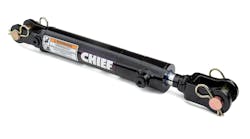Energy Chain, from igus Inc., is widely used to prevent long lengths of electrical and electronic cables and smaller hoses and flexible tubing from getting tangled. Igus now offers E2 hydraulic Energy Chain, which is ideal for use on outriggers and similar applications where long linear motion can otherwise allow hose to get pinched or tangled. The Energy Chain prevents twisting and bending beyond the minimum bend radius also provides an extra line of protection by shielding hose and cable from hostile environments. Rounded contours and wide and smooth contact surfaces keep abrasion and wear of the hydraulic hoses low.
Hoses are also protected by isolating them from electrical cables. This follows the principle that cables and hoses with very different diameters should always be run separately. This is important because power or control cables have a maximum thickness of 5 mm, whereas the hydraulic hoses can be up to 20 mm. Plus a clearance space of 20% normally is required for hydraulic hose because of its expansion when pressurized.
Intended for Heavy-duty Equipment
Strong, space-saving, and easy-to-install, the igus Energy Chain guides two hydraulic hoses in addition to power and control cables. Igus offers "extender crossbars" to provide additional interior space for guiding hoses. Extender and standard crossbars can be used on the E2/000 series and the E4.1 and E4.1L systems with high holding power to accommodate additional hoses or larger-diameter hoses.
The E2 hydraulic chain was developed for installation challenges in support legs on concrete pumps and mobile cranes. A one-piece, solid extender crossbar design and beefed-up pin/bore connections ensure high strength, even for large, unsupported lengths. The extender crossbars are injection-moulded directly on the side link for high stability.
Two hoses can also be placed one on top of the other when width of the two-hose assembly is especially challenging. The hydraulic chain has an external width of just 41.2 mm and an external height of 57.5 mm. The predefined minimum bend radius is 75 mm, allowing the E2 hydraulic chain to be installed close to the base or on the side wall of support legs of a machine.
For more information, call igus Inc., Providence, R.I., at (800) 521-2747, or contact the company via e-mail or its website.


